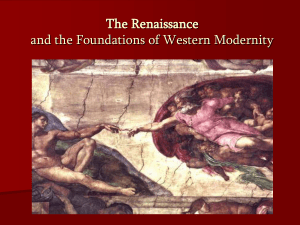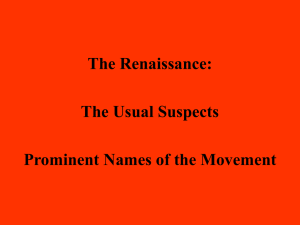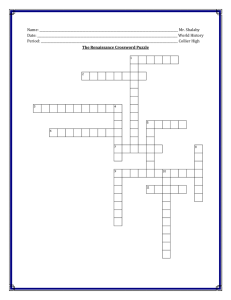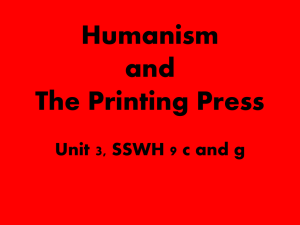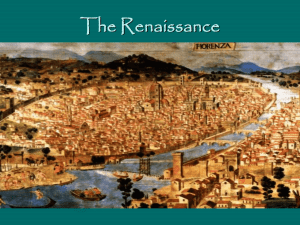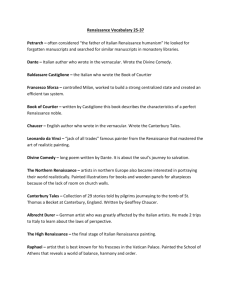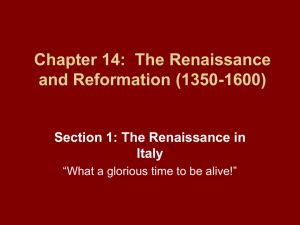People of the Renaissance
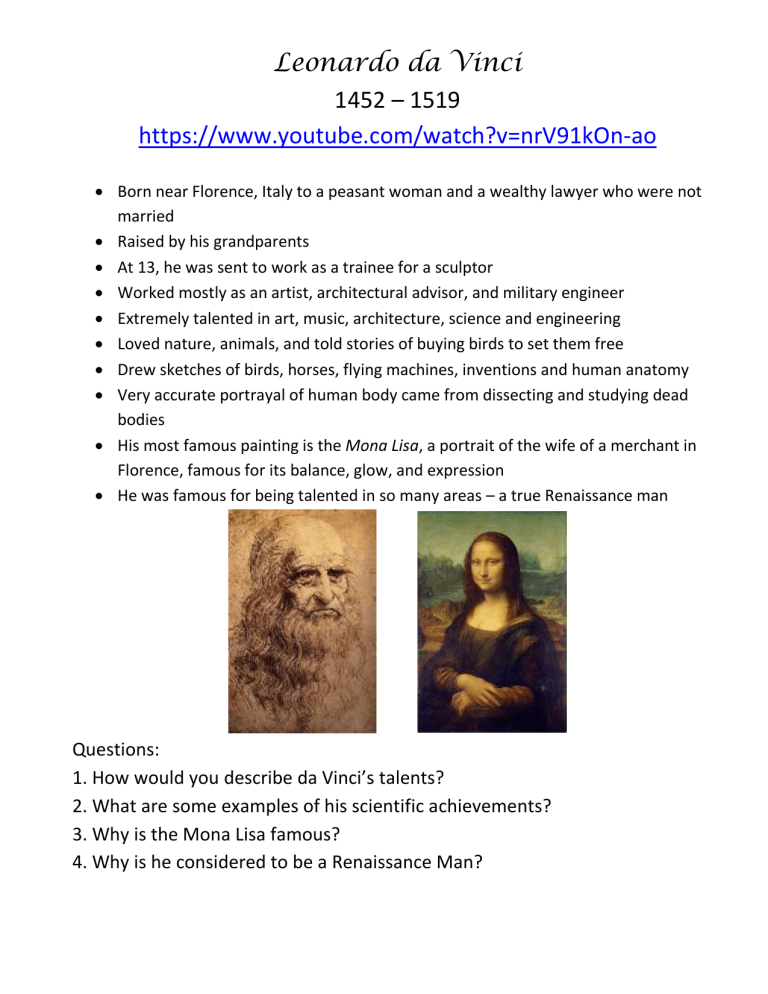
Leonardo da Vinci
1452 – 1519
https://www.youtube.com/watch?v=nrV91kOn-ao
Born near Florence, Italy to a peasant woman and a wealthy lawyer who were not married
Raised by his grandparents
At 13, he was sent to work as a trainee for a sculptor
Worked mostly as an artist, architectural advisor, and military engineer
Extremely talented in art, music, architecture, science and engineering
Loved nature, animals, and told stories of buying birds to set them free
Drew sketches of birds, horses, flying machines, inventions and human anatomy
Very accurate portrayal of human body came from dissecting and studying dead bodies
His most famous painting is the Mona Lisa, a portrait of the wife of a merchant in
Florence, famous for its balance, glow, and expression
He was famous for being talented in so many areas – a true Renaissance man
Questions:
1. How would you describe da Vinci’s talents?
2. What are some examples of his scientific achievements?
3. Why is the Mona Lisa famous?
4. Why is he considered to be a Renaissance Man?
Michelangelo
1475-1564 https://www.youtube.com/watch?v=V6ON7F4Wn4k
Michelangelo Buonarroti was born in Caprese, Italy on March 6, 1475.
His father was a civil servant (worked for the government), and his mother died when he was young.
He grew up in Florence, Italy and at the age of 13 became an artist’s apprentice and was taken under the wing of Lorenzo de Medici, the leader of Florence.
He lived in the Medici palace and studied under the sculptor Bertoldo di Giovanni
In 1494, the Medici family fled from Florence and Michelangelo moved to Rome.
There he was received a commission for his most important early work the Pieta in
1498, which was a sculpture of the Virgin Mary holding the body of Christ in her lap.
His next major commission was for the statue of David for the Florence cathedral.
The 17 foot statue reflects Michelangelo’s study of classical art, human anatomy, and his amazing talent.
From 1508-1512, Michelangelo worked on the paintings on the Sistine Chapel at the
Vatican in Rome.
At the end of his life, Michelangelo turned his attention towards architecture. The
San Lorenzo Chapel for the Medici family and the Laurentine Library are two of his most famous designs.
He was also an accomplished poet, and wrote over 300 poems.
Questions:
1. Which works of art is Michelangelo the most famous for?
2. Why would Michelangelo be considered a “Renaissance Man”?
3. What was his childhood like?
4. Why was Michelangelo’s introduction to the Medici family so important?
Dante Alighieri
1265-1321
Dante was born in Florence, Italy in 1265
He was a poet, but he was also involved in politics.
He was a member of a political group that opposed the pope and wanted Florence to be free from papal power.
Pope Boniface VIII sent troops to Florence to take over the city and Dante was exiled.
Dante wrote The Divine Comedy while in exile.
Dante wrote during the High Middle Ages (transition period to the Renaissance), and this work reflects changes from the Middle Ages to the Renaissance.
He looks to the Roman poet, Virgil, as a guide and sings his praises in The Divine
Comedy.
He wrote The Divine Comedy in Italian, not in Latin.
The Divine Comedy is about Dante taking a journey as a pilgrim through heaven, purgatory and hell. Ultimately, Dante portrays this journey through the different levels of the afterlife as a metaphor for the individual moving through life, recognizing his sins, and hopefully finding peace.
“You have the light that shows you right from wrong, and your Free Will, which, though it may grow faint in its first struggles with the heavens, can still surmount all obstacles if nurtured well.
You are free subjects of a greater power, a nobler nature that creates your mind…
So, if the world today has gone astray, the cause lies in yourselves and only there!”
– Purgatorio XVI.76-83
1. What is Dante most famous for?
2. Why might Dante be considered a Renaissance figure, even if he lived before other
Renaissance writers and artists?
Read the excerpt above from Dante’s work.
3. What is the message of this passage?
4. What evidence do you see of the ideals of humanism?
Francesco Petrarch
1304-1374
He was born in Tuscany (now a part of Italy) in 1304, and moved to France as a child with his family. His father wanted him to study law, but after his father’s death he devoted more time to his true love – classical literature from Ancient Greece and
Rome.
Began a movement to find forgotten classical (Greek and Roman) manuscripts
He looked to Cicero as the model for writing prose and Virgil as the model for writing poetry.
Like Dante, he also wrote poetry in the vernacular (common language, not Latin).
He lived through the plague and lost several loved ones to the disease including his son, his grandson, numerous friends and a woman named Laura who he loved and wrote most of his poems about.
He is considered the Father of Humanism, because he incorporated individualism into his writing and emphasized the morals of the classical era of Greece and Rome rather than the values of the Middle Ages. His writing was secular, whereas most medieval writing and art dealt with religious themes.
You who hear the sound, in scattered rhymes,
Of those sighs on which I fed my heart, in my first vagrant youthfulness,
When I was partly other than I am,
I hope to find pity, and forgiveness,
For all the modes in which I talk and weep,
Between vain hope and vain sadness,
In those who understand love through its trials.
Yet I see clearly now I have become
An old tale amongst all these people, so that
It often makes me ashamed of myself;
And shame is the fruit of my vanities,
And remorse, and the clearest knowledge
Of how the world’s delight is a brief dream.
1. Why is Petrarch considered to be the Father of Humanism?
2. How might his personal experiences have shaped his beliefs about humanism?
3. What influenced his writing?
4. What characteristics of the Renaissance can you see in his life and his writing?
Desiderius Erasmus https://youtu.be/aVe3tgX0RNk
*stop watching at 5:06 minutes.
Born in Rotterdam, Holland in 1466
He was the illegitimate son of a priest
Important Christian humanist
He attended a monastery and became a priest for a few years
He studied philosophy and Greek and learned about Humanism in France, and began to write against the corruption in the church
He was a humanist, so he believed in the importance of education
His most famous work, In Praise of Folly criticized the Catholic Church and called for a more simple form of Christianity
He studied Greek texts of the New Testament and wanted people to return to the sources of the Christian tradition
Even though he criticized the Catholic Church, he did not agree with protests against the Church and he was opposed to violence.
Even though he agreed with some of the ideals of the Protestant Reformation, he remained a Catholic.
1. How do you think Erasmus’ life and experiences shaped his beliefs about humanism and the Catholic Church?
2. Why did Erasmus think the Bible should be translated into the vernacular (common language of the people)?
3. What was Erasmus’ most important work and what was it about?
4. What does the phrase, “Erasmus laid the egg that Luther hatched” mean?
